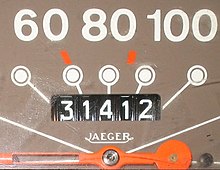Odometry
Odometry or also hodometry (from ancient Greek ὁδός hodós "way" and μέτρον métron "measure" - also "distance measurement") describes a method of estimating position and orientation (position estimation ) of a mobile system based on the data of its propulsion system. Systems driven by wheels use the number of wheel revolutions for this, while running systems (e.g. robots ) use the number of their steps. One device that uses odometry to estimate location is an odometer . Odometry, in conjunction with dead reckoning, is a fundamental navigation method for ground-based vehicles of all types ( motor vehicles , robots), but due to its error properties, it is rarely used as the sole method.
Procedure
The number of wheel revolutions between two measurement times is counted (for example with incremental encoders ) and converted into a path difference together with the known wheel circumference , where the wheel diameter represents :
- .
The direction of the vehicle movement can be determined via the steering angle of the individual wheels, the calculation rule for the steering angle being dependent on the type of chassis ( front-axle control arm, rear-axle control arm ).
Odometric measuring methods enable a relative position determination, since they only work with path differences. For an absolute position specification, a position must be known to which the position differences can be related. In the one-dimensional case (rail vehicle) the equation results
- .
Error consideration
The following variables can influence the accuracy of the position measurement.
- Wheel geometry (out-of-roundness, wear, incorrect measurement of the diameter, cross profile of the wheel)
- Material and air pressure (profile, softness of the material, softness due to inflation pressure, temperature, speed)
- Soil condition (unevenness, slippage )
- Chassis geometry (play, incorrect measurement of wheel distances and steering devices)
- Vehicle weight (uneven distribution: increased load and deformation of individual wheels)
- wind
All errors are included in the position difference, which is added to the last known position. Thus, the errors add up with every measurement step, and the longer the measurement takes, the greater the deviation. This control difference (following error) in the odometric position calculation is practically unavoidable, even if all error influences are minimized.
application
Vehicle technology
Odometry refers to a functionality that determines the position, orientation and driving condition of a vehicle at certain times. As a rule, the input variables are measured variables from the chassis (wheel rotation, direction), the yaw rate sensor (ESP / ABS) and the steering (wheel steering angle, steering wheel angle). In vehicle navigation , it is used in addition to GPS location, in order to bridge areas without reception such as tunnels and to refine the GPS results.
ETCS odometry is used for the safe position and speed measurement of trains.
robotics
In autonomous robotics, odometry is one of the simplest and therefore one of the most common tools for localization . As a rule, the odometry measurements are supplemented by further sensors - typically echolocation or GPS - in order to obtain better results.
Sources and Notes
- ^ Joachim Hertzberg, Kai Lingemann, Andreas Nüchter: Mobile Robots. An introduction from the point of view of computer science (= eXamen.press. ). Springer Vieweg, Berlin et al. 2012, ISBN 978-3-642-01725-4 .






